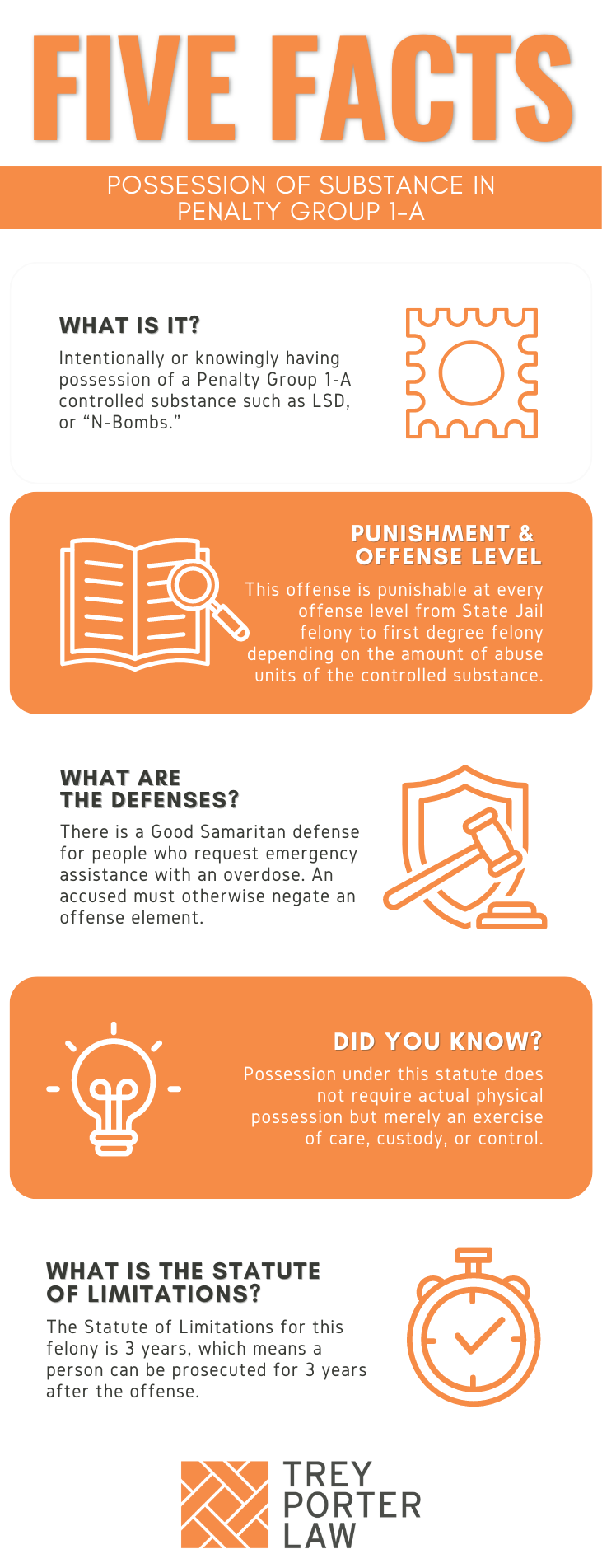WHAT IS POSSESSION OF SUBSTANCE IN PENALTY GROUP 1-A IN TEXAS?
The Texas law against possession of substance in Penalty Group 1-A prohibits intentionally or knowingly having care, custody, control, or management of a controlled substance listed in Penalty Group 1-A.

- What is a controlled substance? Texas Health and Safety Code Section 481.002 defines a “controlled substance” as a substance, including a drug, listed in Schedules I through V or Penalty Group 1, 1-A, 1-B, 2, 2-A, 3, or 4. The term includes the aggregate weight of any mixture, solution, or other substance containing a controlled substance, but does not include “hemp” as defined by Texas Agriculture Code Section 121.001, or the tetrahydrocannabinols in hemp.
- What is the difference between Schedules I, II, III, IV, and V and the penalty groups of controlled substances? Controlled substances are divided into five “schedules” based on potential for abuse or addiction, which dictate the rules medical professionals must follow in prescribing medications listed in each schedule. Schedule I, for example, are the most addictive substances, and may generally not be prescribed. Substances in Schedule I are also typically in Penalty Group 1, and are considered illegal under most circumstances.Controlled substances are divided into “penalty groups” for determining criminal classification and penalties.
- What controlled substances are in Penalty Group 1-A in Texas? Texas Health and Safety Code Section 481.1021 lists the following controlled substances in Penalty Group 1-A:
-
- lysergic acid diethylamide (LSD), including its salts, isomers, and salts of isomers; and
- compounds structurally derived from 2,5-dimethoxyphenethylamine by substitution at the 1-amino nitrogen atom with a benzyl substituent, including compounds further modified by:
- substitution in the phenethylamine ring at the 4-position to any extent (including alkyl, alkoxy, alkylenedioxy, haloalkyl, or halide substituents); or substitution in the benzyl ring to any extent (including alkyl, alkoxy, alkylenedioxy, haloalkyl, or halide substituents); and
- compounds such as:
- 4-Bromo-2,5-dimethoxy-N-(2-methoxybenzyl)phenethylamine (trade or other names: 25B-NBOMe, 2C-B-NBOMe);
- 4-Chloro-2,5-dimethoxy-N-(2-methoxybenzyl)phenethylamine (trade or other names: 25C-NBOMe, 2C-C-NBOMe);
- 2,5-Dimethoxy-4-methyl-N-(2-methoxybenzyl)phenethylamine (trade or other names: 25D-NBOMe, 2C-D-NBOMe);
- 4-Ethyl-2,5-dimethoxy-N-(2-methoxybenzyl)phenethylamine (trade or other names: 25E-NBOMe, 2C-E-NBOMe);
- 2,5-Dimethoxy-N-(2-methoxybenzyl)phenethylamine (some trade and other names: 25H-NBOMe, 2C-H-NBOMe);
- 4-Iodo-2,5-dimethoxy-N-(2-methoxybenzyl)phenethylamine (some trade and other names: 25I-NBOMe, 2C-I-NBOMe);
- 4-Iodo-2,5-dimethoxy-N-benzylphenethylamine (trade or other name: 25I-NB);
- 4-Iodo-2,5-dimethoxy-N-(2,3-methylenedioxybenzyl)phenethylamine (trade or other name: 25I-NBMD);
- 4-Iodo-2,5-dimethoxy-N-(2-fluorobenzyl)phenethylamine (trade or other name: 25I-NBF);
- 4-Iodo-2,5-dimethoxy-N-(2-hydroxybenzyl)phenethylamine (trade or other name: 25I-NBOH);
- 2,5-Dimethoxy-4-nitro-N-(2-methoxybenzyl)phenethylamine (trade or other names: 25N-NBOMe, 2C-N-NBOMe); and
- 2,5-Dimethoxy-4-(n)-propyl-N-(2-methoxybenzyl)phenethylamine (some trade and other names: 25P-NBOMe, 2C-P-NBOMe).
WHAT IS THE POSSESSION OF SUBSTANCE IN PENALTY GROUP 1-A LAW IN TEXAS?
Tex. Health & Safety Code § 481.1151. OFFENSE: POSSESSION OF SUBSTANCE IN PENALTY GROUP 1-A.
(a) Except as provided by this chapter, a person commits an offense if the person knowingly possesses a controlled substance listed in Penalty Group 1-A.
(b) An offense under this section is:
(1) a state jail felony if the number of abuse units of the controlled substance is fewer than 20;
(2) a felony of the third degree if the number of abuse units of the controlled substance is 20 or more but fewer than 80;
(3) a felony of the second degree if the number of abuse units of the controlled substance is 80 or more but fewer than 4,000;
(4) a felony of the first degree if the number of abuse units of the controlled substance is 4,000 or more but fewer than 8,000; and
(5) punishable by imprisonment in the Texas Department of Criminal Justice for life or for a term of not more than 99 years or less than 15 years and a fine not to exceed $250,000, if the number of abuse units of the controlled substance is 8,000 or more.
(c) It is a defense to prosecution for an offense punishable under Subsection (b)(1) that the actor:
(1) was the first person to request emergency medical assistance in response to the possible overdose of another person and:
(A) made the request for medical assistance during an ongoing medical emergency;
(B) remained on the scene until the medical assistance arrived; and
(C) cooperated with medical assistance and law enforcement personnel; or
(2) was the victim of a possible overdose for which emergency medical assistance was requested, by the actor or by another person, during an ongoing medical emergency.
(d) The defense to prosecution provided by Subsection (c) is not available if:
(1) at the time the request for emergency medical assistance was made:
(A) a peace officer was in the process of arresting the actor or executing a search warrant describing the actor or the place from which the request for medical assistance was made; or
(B) the actor is committing another offense, other than an offense punishable under Section 481.115(b), 481.116(b), 481.1161(b)(1) or (2), 481.117(b), 481.118(b), or 481.121(b)(1) or (2), or an offense under Section 481.119(b), 481.125(a), 483.041(a), or 485.031(a);
(2) the actor has been previously convicted of or placed on deferred adjudication community supervision for an offense under this chapter or Chapter 483 or 485;
(3) the actor was acquitted in a previous proceeding in which the actor successfully established the defense under that subsection or Section 481.115(g), 481.116(f), 481.1161(c), 481.117(f), 481.118(f), 481.119(c), 481.121(c), 481.125(g), 483.041(e), or 485.031(c); or
(4) at any time during the 18-month period preceding the date of the commission of the instant offense, the actor requested emergency medical assistance in response to the possible overdose of the actor or another person.
(e) The defense to prosecution provided by Subsection (c) does not preclude the admission of evidence obtained by law enforcement resulting from the request for emergency medical assistance if that evidence pertains to an offense for which the defense described by Subsection (c) is not available.
WHAT IS THE PENALTY CLASS FOR POSSESSION OF SUBSTANCE IN PENALTY GROUP 1-A IN TEXAS?
The penalty classification for possession of a controlled substance in Penalty Group 1-A depends on the number of abuse units in the person’s possession.
- What is an abuse unit? Texas Health and Safety Code Section 481.002 defines an “abuse unit” as:
-
- a single unit on or in any adulterant, dilutant, or similar carrier medium, including marked or perforated blotter paper, a tablet, gelatin wafer, sugar cube, or stamp, or other medium that contains any amount of a controlled substance listed in Penalty Group 1-A, if the unit is commonly used in abuse of that substance; or
- each quarter-inch square section of paper, if the adulterant, dilutant, or carrier medium is paper not marked or perforated into individual abuse units; or
- if the controlled substance is in liquid or solid form, 40 micrograms of the controlled substance including any adulterant or dilutant.
For example, an abuse unit of 25I-NBOMe (“N-Bomb,” or “Smiles”), a synthetic hallucinogen, is a small square stamp meant to be placed under the tongue.
The penalty class for possession of a controlled substance in Penalty Group 1-A is a:
- State jail felony, punishable by 180 days to two years in a state jail facility, if:
- the number of abuse units is fewer than 20;
- Third degree felony, punishable by two to ten years in prison, if:
- the number of abuse units is 20 or more but fewer than 80
- Second degree felony, punishable by two to 20 years in prison, if:
- the number of abuse units is 80 or more but fewer than 4,000;
- First degree felony, punishable by five to 99 years or life in prison, if:
- the number of abuse units is 4,000 or more but fewer than 8,000;
- First degree felony, punishable by 15 to 99 years or life in prison, if:
- the number of abuse units is over 8,000.
Texas Health and Safety Code Section 481.134 increases the minimum prison sentence by five years and doubles the fine for possession of a controlled substance in Penalty Group 1-A categorized as a felony, other than a state jail felony, if the offense was committed in a “drug-free zone.” If the offense was a state jail felony committed in a drug-free zone, the penalty classification is increased to a third degree felony.
- What is a drug-free zone in Texas? Texas Health and Safety Code Section 481.134 describes a drug-free zone as:
- in, on, or within 1,000 feet of premises of a school (including a day-care center), of premises owned, rented, or leased by an institution of higher learning, the premises of a public or private youth center, or a playground;
- on a school bus; or
- in, on, or within 1,000 feet of premises owned, rented, or leased by a general residential operation operating as a residential treatment center.
WHAT IS THE PUNISHMENT RANGE FOR POSSESSION OF SUBSTANCE IN PENALTY GROUP 1-A IN TEXAS?
The punishment range for possession of a controlled substance in Penalty Group 1-A corresponds to the penalty classification, which depends on the number of abuse units.
- 8,000 abuse units or more (first degree felony):
- 15 to 99 years or life in prison, maximum $250,000 fine; or
- 4,000 units or more but less than 8,000 units (first degree felony):
- five to 99 years or life in prison, maximum $10,000 fine;
- 80 units or more but less than 4,000 units (second degree felony):
- two to 20 years in prison, maximum $10,000 fine;
- 20 units or more but less than 80 units (third degree felony):
- two to ten years in prison, maximum $10,000 fine;
- Fewer than 20 units (state jail felony):
- 180 days to two years in a state jail facility, maximum $10,000 fine.
WHAT ARE THE PENALTIES FOR POSSESSION OF SUBSTANCE IN PENALTY GROUP 1-A IN TEXAS?
A person charged with possession of less than one gram of a controlled substance in Penalty Group 1-A as a state jail felony is eligible for deferred adjudication without a conviction. If it is the person’s first felony conviction, the person may not be sent to a state jail facility, and must be placed on community supervision for a period between two and five years, with the possibility of extending supervision for up to ten years.
The period of deferred adjudication for a third degree felony possession of a controlled substance in PG 1-A charge may not exceed ten years, and the probation period may range from two and five years. If charged with possessing a greater amount, the maximum supervision period is ten years.
WHAT ARE THE DEFENSES TO POSSESSION OF SUBSTANCE IN PENALTY GROUP 1-A IN TEXAS?
Texas Health and Safety Code Section 481.123 provides a defense to a person charged with manufacturing, delivering, or possessing a controlled substance if the substance was approved as a new drug by the FDA, or was exempt by the FDA for investigational use.
- What is the Good Samaritan defense in Texas? The Texas Health and Safety Code permits a person accused of possession of a controlled substance in PG 1-A to raise a Good Samaritan defense at trial if the person was the first to request emergency medical assistance in response to an ongoing possible overdose of the person or another, stayed until first responders arrived, and cooperated with medical and law enforcement personnel.A person accused of possession of a controlled substance may only benefit from the Good Samaritan defense if the person was the first to call 911, and cooperated with first responders upon arrival. The Good Samaritan defense is not available if the police were executing a search warrant at the time of the offense, if the accused was committing an additional offense, or if the accused has prior drug convictions.If the accused has successfully raised the Good Samaritan defense in a previous case, or called 911 for an overdose within the 18-month period preceding the instant offense, the person may not raise the Good Samaritan defense at a subsequent trial for possession of a controlled substance.
- Is a lab test required in drug cases in Texas? Generally, yes. A person should not be convicted of possessing, manufacturing, or delivering a controlled substance in a specifically alleged penalty group without a lab report verifying the drug was the controlled substance alleged.In Ex parte Saucedo, the defendant was indicted for possession of methamphetamine, a controlled substance in Penalty Group 1. He pled before the lab results were sent to the prosecution, and was sentenced. The lab report revealed the defendant was actually in possession of methylethcathinone, a substance in Penalty Group 2. The Court of Criminal Appeals granted habeas relief, and cautioned all trial attorneys and defendants against pleading without all the evidence.
- What is drug possession in Texas? Texas Health and Safety Code Section 481.002 defines “possession” as actual care, custody, control, or management. Possession does not require proof a person is physically holding the controlled substance.In Rodriguez v. State, No. 04-21-00503-CR, the defendant’s girlfriend let her friend drive the defendant to the store. Police stopped the car while the defendant was in the passenger seat, and found 0.18 grams of methamphetamine in a chewing tobacco tin in the glove box. The officer noticed tobacco around the defendant’s mouth, so he was charged with and convicted of possession of less than a gram of a controlled substance in Penalty Group 1.The appellate court affirmed. The drugs were conveniently accessible to the defendant on his side of the car, they were in a tobacco tin, and the defendant chewed tobacco.
- What is a search incident to arrest in Texas? The Fourth Amendment to the U.S. Constitution permits police officers to conduct warrantless searches incident to lawful arrests. The justification for permitting such a warrantless search is: (1) the need for officers to seize weapons or other things which might be used to assault an officer or effect an escape; and (2) the need to prevent the loss or destruction of evidence. See State v. Granville, 423 S.W.3d 399, 410 (Tex. Crim. App. 2014).In State v. Sanchez, an officer approached the defendant’s jeep, which was parked in a grassy area next to a bar with the driver’s door open, the engine turned off, and the defendant was asleep in the driver’s seat. The officer woke the defendant up to check on him, and learned he had traffic warrants. Incident to arrest, the officer searched the defendant’s pockets, and he had cocaine. He was then arrested for possession of a controlled substance in PG 1, his car was searched incident to that arrest, and more cocaine was found. The appellate court upheld the car search as a valid search incident to his arrest for possession.In Botello v. State, police responded to an assault-in-progress. The officer spoke to the victim outside the home, who said the defendant was her estranged husband, had assaulted her, and was still inside. The defendant refused to come out, but the victim consented to a search of the home, so police forcefully went inside. Officers immediately arrested the defendant for assault, searched his pockets, and found over 24 grams of heroin. He was convicted of possession of a controlled substance in PG 1, and the appellate court affirmed.
WHAT IS THE STATUTE OF LIMITATIONS FOR POSSESSION OF SUBSTANCE IN PENALTY GROUP 1-A IN TEXAS?
The limitation period for possession of a substance in Penalty Group 1-A is three years.
POSSESSION OF SUBSTANCE IN PENALTY GROUP 1-A IN TEXAS
Texas punishes possession of a controlled substance in Penalty Group 1-A in any usable amount as a felony.
TEXAS POSSESSION OF SUBSTANCE IN PENALTY GROUP 1-A COURT CASES
The case law regarding possession of substance in Penalty Group 1-A in Texas illustrates the statute’s application.
- In Jackson v. State, an officer was working security at an apartment complex, and saw the defendant walking away from what he suspected was a drug transaction. The officer approached the defendant and immediately smelled PCP (phencyclidine), an odor similar to nail polish remover. He saw the defendant holding a “PCP stick,” which is a cigarette dipped in liquid PCP. The defendant admitted to having another PCP stick.The defendant was ultimately convicted of possession of a controlled substance in PG 1-A. The total weight was 1.93 grams, which included the cigarettes themselves. The appellate court affirmed, explaining “adulterants and dilutants” are anything that adds to a controlled substance to increase the weight or quantity, regardless of the effect on the substance.
















